Looking Back — live & direct from the Asia Pacific Triennial stage
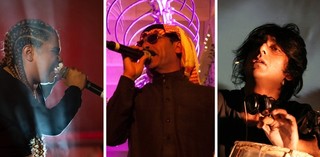
BARKAA, Omar Souleyman, and Talvin Singh live & direct from the Asia Pacific Triennial stage / View full image
Since the Gallery of Modern Art opened with 'The 5th Asia Pacific Triennial of Contemporary Art' in 2006, the exhibition series has welcomed a wealth of live music from around the world during electrifying opening events and special programs through each subsequent edition of the Gallery’s flagship contemporary art event. A hallmark of the best Triennial performances has been a focus on fusion, whether of the resolutely contemporary and the deeply traditional, or of different sonic cultures finding harmony from seemingly dissonant alignment.
In the lead up to the opening of the 11th chapter (30 November 2024 – 27 April 2025) here are just a handful of the most notable performances over the years.
Turning the tablas
In the catalogue for the fifth Triennial, Dr Rupa Huq considered the multi-directional migratory flow of musical influences between Great Britain and South Asia. Seen in acts as diverse as Cornershop, Fun-Da-Mental and Asian Dub Foundation, this fusion was perhaps epitomised by the second-generation British Indian producer and table player Talvin Singh. Cutting his teeth on studio work with Souxsie and the Banshees and Björk, Singh went on to win Britain’s prestigious Mercury Prize with his solo debut OK in 2008. His performance at the fifth Triennial, which also marked the opening of the Gallery of Modern Art, incorporated tabla and CDJs, traversing the traditional — reflecting his own Punjabi heritage as well as the Carnatic music of south India — and the cutting edge of breaks-driven club music.
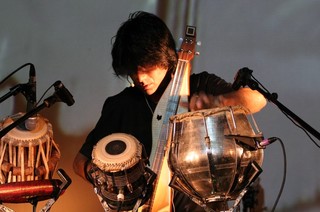
Talvin Singh at the opening of ‘The 5th Asia Pacific Triennial of Contemporary Art’, December 2006 / Photograph: J Bell © QAGOMA / View full image
To the heart of the Pacific
The sixth Triennial’s Pacific Reggae project, co-curated by broadcaster and selector Brent Clough, looked at how a distinctly Oceanic strain of reggae music had taken root from Hawai’i to Aoteroa New Zealand, thanks perhaps to the climatic, geographic and colonial resonances between the Caribbean and the Pacific. The project featured in the exhibition with an installation of music videos by artists from Aotearoa New Zealand, New Caledonia, Vanuatu, Solomon Island and Fiji, and in the catalogue with a bonus CD compilation. On the exhibition’s opening night, Brisbane Pacific community stormed the Gallery of Modern Art for a free performance by Papua New Guinea/Hawai’i reggae legend O-Shen.
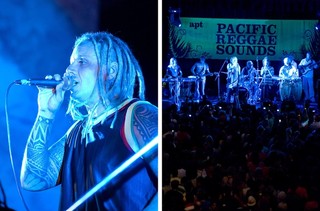
O-Shen (left) and band at Pacific Reggae Sounds concert for the opening of ‘The 6th Asia Pacific Triennial of Contemporary Art’, December 2009 / Photograph: N Harth © QAGOMA / View full image
The wedding singer
Performing beneath the soaring serpentine coil of Huang Yong Ping’s Ressort, Syrian folk singer Omar Souleyman lit up the Watermall on the opening weekend of the seventh Asia Pacific Triennial in 2012. Souleyman’s raucously stomping take on traditional Levantine dabke music stems from his career as an in-demand wedding singer, a line of work which generated several hundred live recordings. Peddled through regional markets, these tapes eventually caught the ear of American producers and labels, launching a new global lease on life for Souleyman’s melting-pot of sounds that reflect the richness of north-eastern Syria, drawing influence from Kurdish, Arabic and even Turkish and Iraqi cultures.
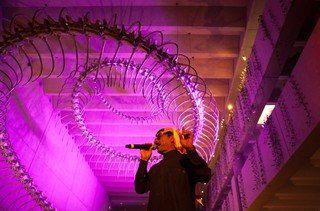
Omar Souleyman performs on the Queensland Art Gallery Watermall during ‘The 7th Asia Pacific Triennial of Contemporary Art’, December 2012 under Huang Yong Ping's Ressort 2012 commissioned 2012 with funds from Tim Fairfax AM through the QAG Foundation / © Huang Yong Ping/Copyright Agency / Photograph: B Standen © QAGOMA / View full image
Jakarta juke-joint
In 2015, the eighth Triennial was inaugurated by Indonesian pop outfit White Shoes and The Couples Company. With tinges of bossa nova, disco and film music in the mix, the angelic vocals of Aprilia Apsari (who also illustrates some of the group’s album art) soared atop a wash of uptempo instrumentation to bring the Watermall crowd to a frenzied crescendo.
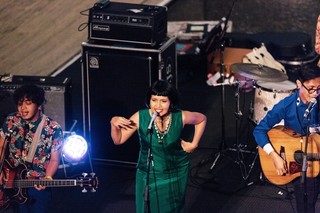
White Shoes & the Couples Company at ‘The 8th Asia Pacific Triennial of Contemporary Art’, December 2015 / Photograph: J Ruckli © QAGOMA / View full image
Are fields electric?
The ninth Triennial, in 2018, saw a packed Summer Festival edition of Up Late headlined by Australian electronic sensation Electric Fields. The duo of vocalist Zaachariaha Fielding, who sings in the Western desert languages of Pitjantjatjara and Yankunytjatjara as well as English, and producer Michael Ross, lured a capacity crowd to the Gallery of Modern Art’s River Room. As well as Electric Fields taking the world (including Eurovision) by storm since, Fielding himself is a compelling visual artist, receiving the Art Gallery of New South Wales’ Wynne Prize in 2023.
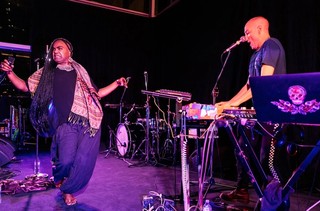
Electric Fields at Summer Festival Up Late for ‘The 9th Asia Pacific Triennial of Contemporary Art’, January 2019 / Photograph: J Ruckli © QAGOMA / View full image
Rhyme spree
The tenth Triennial was a muted affair at first, its opening weekend hobbled by border closures thanks to then-ongoing pandemic. Things got moving in early 2022 with a special two-night Up Late event that perfectly reflected the Triennial’s diasporic diversity. The first night was a bar-fest with Sydney rapper L-FRESH The LION tapping his Punjabi and Sikh roots plus a fierce, raw set by Malyangapa and Barkindji MC BARKAA. The following evening, the critically acclaimed Butchulla hip hop artist BIRDZ, was the headliner, with support from the scintillating Sydney-based Korean rap crew 1300.
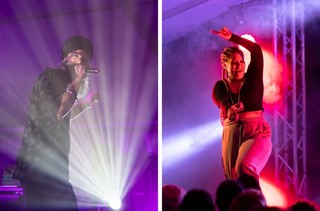
L-FRESH the LION (left) and BARKAA at Up Late for ‘The 10th Asia Pacific Triennial of Contemporary Art’, March 2022 / Photographs: Chloë Callistemon © QAGOMA / View full image
Hidden bonus track
As legend has it, The Kuda were a 70s punk band from Jakarta that developed an unlikely following in Brisbane, partially attributable to the cities’ twin repressive regimes — Suharto in Indonesia and Bjelke-Petersen in Queensland. That is, they would have, if they’d actually existed. The Kuda was in fact an elaborate project by Indonesian art collective ruangrupa, with ephemera from the band’s imagined history included in the group’s installation for the seventh Triennial. Ruangrupa worked with Brisbane-based artists, musicians and enthusiasts to simulate The Kuda’s graphic imagery, songs and anecdotal accounts — even drafting local musicians to perform a tribute to The Kuda under the name The Family Butchers.
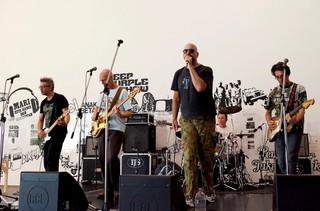
Amid an installation by Indonesian art collective ruangrupa, The Family Butchers perform a tribute to The Kuda, at the opening weekend of ‘The 7th Asia Pacific Triennial of Contemporary Art’, December 2012 / Photograph: C Callistemon © QAGOMA / View full image
Dan Cameron is Senior Communication Officer, QAGOMA
Art that turns up the volume
Asia Pacific Triennial
Queensland Art Gallery & Gallery of Modern Art
30 November 2024 – 27 April 2025

